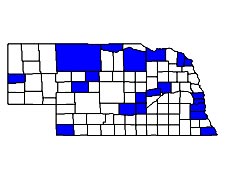
| Cicindela cuprascens LeConte |
| Adult Length: 12 to 15 mm |
| Appearance: The dorsal surface is shiny bronze to brassy colored. Maculation on the elytra is generally quite sinuous, particularly the middle band and poshumeral mark. The humeral mark is normally very well developed and somewhat triangular in shape and the posthumeral mark extends at an angle toward the posterior and is upturned at the end. The middle band is usually somewhat reticulated on the inner side between the “foot” and the “knee”. The body shape is somewhat narrow in comparison with most other Nebraska tiger beetles. |
| Similar Species: This species is easily confused with C. macra or C. nevadica knausi. It can be differentiated by its shiny appearance as C. macra is somewhat duller in luster. In C. nevadica knausi the humeral mark is not triangular, and the middle band is not usually reticulated. It might also be confused with C. hirticollis, but the posthumeral mark is distinctive. In C. macra the posthumeral mark extends at an angle toward the posterior and is partially recurved at the end. In C. hirticollis the mark is also recurved at the end, but initially extends laterally or even slightly toward the anterior. |
| Biology: This species occurs on river sandbars or rarely on lake beaches, often alongside C. macra. It is usually not numerous. Like C. macra, it is quite skittish, but is usually not a long flier. Both species can be attracted to lights at night. |
| Adult Life History: Adults emerge from the pupa in late June and July, and peak numbers occur in July. A few adults may survive into late August and September. It is a summer species. |
| Larval Life History: Eggs are laid mostly in July and most larvae probably reach the second instar by fall before overwintering. The third instar is reached the following summer before a second overwintering period, and the adults emerge the summer thereafter. The total larval life cycle lasts two years. Larvae occur in moist sandy soils and the burrows are said to have a ragged appearance with a crater-like opening. |
| Biogeography: This species has been recorded from scattered locations across Nebraska. It appears to be consistent at some sites in the Loup River system and probably occurs in several counties within this river system from which it has not yet been recorded. At least one small population which occurred along a small stream in Buffalo County was virtually eliminated by the construction of a small dam in 2003/2004. In North America it occurs from the Ohio River Valley to Mississippi and across southern Illinois and Texas to northeastern New Mexico, eastern Montana, North Dakota, and the southwestern edge of Manitoba. |


